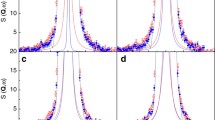Abstract
Data on the thermogravimetry, spectroscopy, and electrical charge transfer as functions of T, aH2O, and aO2 for niobates and tantalates of alkali-earth metals with structure disordering of the oxygen sublattice, which can show high-temperature proton conduction, are summarized. It is shown that in the solid solution series with decreasing x (that is, with the increasing of the oxygen vacancies concentration) the proton conductivity increase, which is caused by the increasing of both the concentration of proton defects formed in the structure (in compliance with the formula Sr6 − 2x M +52 + 2x O10(OH)2−6x and their mobility. The proton transfer dominates for the compositions with x < 0.15 at temperatures below 550°C. In the solid solutions (Ba1−y Ca y )6Nb2O11 (0.23 ≤ y ≤ 0.47) characterized by equal concentration of oxygen vacancies, with the increasing of barium content (correspondingly, with the increasing of the lattice parameter) the oxygen-ion conductivity (at aH2O = 3 × 10−5) grows monotonically, which is caused by the decreasing of the oxygen atom migration energy and increasing of their mobility. In this series, the proton conductivity (at aH2O = 2 × 10−2) increased. It was shown, by using IR-spectroscopy and the 1H NMR method, that the protons exist in the complex oxide structure mainly as energy-wise nonequivalent OH− groups: isolated, closely set, and paired, whose quantitative ratios are determined by the coordination preference of the B-sublattice elements.
Similar content being viewed by others
References
Pal’guev, S.F., Vysokotemperaturnye protonnye tverdye elektrolity (TRANSLATION), Yekaterinburg: Ural. Otd. Ross. Akad. Nauk, 1998.
Glockner, R., Neiman, A., Larring, Y., and Norby, T., Solid State Ionics, 1999, vol. 125, p. 369.
Animitsa, I., Neiman, A., Sharafutdinov, A., and Nochrin, S., Solid State Ionics, 2000, vol. 136–137, p. 265.
Animitsa, I.E., Neiman, A.Ya., Sharafutdinov, A.R, and Kazakova, M.G., Elektrokhimiya, 2001, vol. 37, p. 305 [Russ. J. Elektrochem. (Engl. Transl.), vol. 37, p.].
Animitsa, I., Norby, T., Marion, S., Glockner, R., and Neiman, A., Solid State Ionics, 2001, vol. 145, no. 1–4, p. 357.
Colomban, Ph., Romain, F., Neiman, A., and Animitsa, I., Solid State Ionics, 2001, vol. 145, no. 1–4, p. 339.
Animitsa, I.E., Titova, S.G., Neiman, A.Ya., Kochetova, N.A., Bronin, D.I., and Isaeva, E.V., Kristallografiya, 2002, vol. 47, p. 1077 [Crystallogr. Rep. (Engl. Transl.), vol. 47, p.].
Animitsa, I., Neiman, A., Kochetova, N., Melekh, B., and Sharafutdinov, A., Solid State Ionic, p. 2003.
Animitsa, I., Denisova, T., Neiman, A., Nepryahin, A., Kochetova, N., Zhuravlev, N., and Colomban, Ph., Solid State Ionics, 2003, vol. 162–163, p. 73.
Animitsa, I., Neiman, A., Titova, S., Kochetova, N., Isaeva, E., Sharafutdinov, A., Timofeeva, N., and Colomban, Ph., Solid State Ionics, 2003, vol. 156, p. 95.
Animitsa, I., Neiman, A., Kochetova, N., Korona, D., and Sharafutdinov, A., Solid State Ionics, 2006, vol. 177, p. 2363.
Animitsa, I.E., Neiman, A.Ya., Kochetova, N.A., and Korona, D.V., Elektrokhimiya, 2006, vol. 42, p. 361 [Rus. J. Electrochem. (Engl. Transl.), vol. 42, p.].
Kochetova, N.A., Cand. Sci. (Chem.) Dissertation, Yekaterinburg: UrGU, 2006.
Kochetova, N.A., Animitsa, I.E., and Neiman, A.Ya., Fizicheskaya khimiya, 2009, no. 2, vol. 83, p. 269.
Korona, D.V., Neiman, A.Ya., Animitsa, I.E., and Sharafutdinov, A.R., Elektrokhimiya, 2009, vol. 45, no. 5 [Rus. J. Electrochem. (Engl. Transl.), vol. 45, no. 5].
Animitsa, I.E., Kochetova, N.A., and Neiman, A.Ya., Elektrokhimiya, 2009 (in press).
Kochetova, N.A., Animitsa, I.E., and Neiman, A.Ya., Elektrokhimiya, 2009 (in press).
Smolenskii, G.A., Isupov, V.A., and Pronin, I.P., in Problemy kristallografii: Sb. nauch. trudov (Problems of Crysallography: Collection of Works), Moscow: Nauka, 1987, p. 268.
Yukhnevich, G.V., Infrakrasnaya spektroskopiya vody (Infrared Spectroscopy of Water), Moscow: “Nauka”, 1973.
Author information
Authors and Affiliations
Corresponding author
Additional information
Original Russian Text © I.E. Animitsa, 2009, published in Elektrokhimiya, 2009, Vol. 45, No. 6, pp. 712–721.
Published by report at IX Conference “Fundamental Problems of Solid State Ionics”, Chernogolovka, 2008
Rights and permissions
About this article
Cite this article
Animitsa, I.E. High-temperature proton conductors with structure-disordered oxygen sublattice. Russ J Electrochem 45, 668–676 (2009). https://doi.org/10.1134/S1023193509060081
Received:
Published:
Issue Date:
DOI: https://doi.org/10.1134/S1023193509060081



